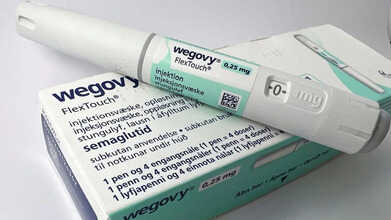- Health Conditions A-Z
- Health & Wellness
- Nutrition
- Fitness
- Health News
- Ayurveda
- Videos
- Medicine A-Z
- Parenting
Common Blood Pressure Drug Hydralazine Could Slow Down Cancer

Credits: Canva
In an accidental discovery where scientists were studying a common blood pressure drug called hydralazine, found out that it could in fact, fight cancer.
What Is Hydralazine?
Most commonly known by its brand name Apresoline, Hydralazine is a prescription medication, which is mainly used to treat high blood pressure or hypertension and heart failure. It works as a direct-acting vasodilator that relaxes the blood vessels, and allows blood to flow more easily and reduce the heart's workload.
This drug is commonly consumed orally and is prescribed by a GP to be taken two to four a day, depending on the severity of one's case. However, the drug can only control blood pressure, and not cure it. It is also used after heart valve replacement and in the treatment of heart failure.
Does Hydralazine, A Common Blood Pressure Drug Fight Cancer?
Kyosuke Shishikura, a physician-scientist at the University of Pennsylvania along with a wider research team uncovered that hydralazine directly targets a small, but a crucial enzyme called 2-aminoethanethiol dioxygenase (ADO).
In a press release, Shishikura said, "It came from a ‘pre-target’ era of drug discovery, when researchers relied on what they saw in patients first and only later tried to explain the biology behind it."
So, How does This Common Blood Pressure Drug Work To Fight Cancer?
The enzyme acts like a cellular oxygen sensor and helps the cells survive even when the oxygen levels are low. This can thus help enable the fast-growing tumors like glioblastoma, which is an aggressive form of brain cancer that resists treatment and almost always comes back.
What Happens In A Fast-growing Cancer Like Glioblastoma?
In glioblastoma, the tumor cells multiply rapidly and the blood supply therefore cannot keep up. This means parts of tumor do not get enough oxygen. While the typical cells die in low-oxygen environment, a tumor cell could switch on its survival system that could help them continue to survive even when the oxygen is scarce. This also involved the ADO enzyme.
In the same press release Megan Matthews, who is an assistant professor in Penn's Department of Chemistry and a researcher in the study said, "ADO is like an alarm bell that rings the moment oxygen starts to fall."
How Did The Research Team Approach This Study?
The team used advanced techniques, which also included X-ray crystallography, which analyzes the structure of molecules to determine how hydralazine binds to ADO. The researchers discovered that hydralazine silences that alarm by binding ADO and making it stop working, which means the tumor cells will not be able to survive even when the oxygen is low. This, as the researchers explained, in turn, shuts down the cell's oxygen response system, and forces the cancer cells to stop dividing them.
Was This Theory Of Common Blood Pressure Drug Fighting Cancer Tested?
The scientists tested this theory on human glioblastoma cells with hydralazine in the lab. After three days, they found out that the cells had stopped multiplying and became larger and flatter. The cell entered, what the scientists called a permanent "sleep mode", which is known as "senescence".
However, it is important to note that the drug did not kill the cells, but it took away the cell's ability to grow and spread.
As per Memorial Sloan Kettering Cancer Center, this is a huge step towards controlling cancers like glioblastoma, as they are extremely difficulty to treat, and they often return even after surgery and chemotherapy. The good news is that budralazine is already FDA-approved, and researchers are hoping that this drug could reshape the cancer therapy.
Liev Schreiber Hospitalized Again, Could It Be Related To Transient Global Amnesia?

Credits: Wikimedia Commons
Liev Schreiber, American actor, best known for his role in Spotlight, and latest seen at the Stranger Things promotional events alongside his daughter Kai Schreiber, was rushed to hospital on Sunday. The actor said that he was suffering from a "brutal headache".
The TMZ reported the health scare after he was being hospitalized in the New York City, and stayed overnight Sunday in the hospital on the advice of his doctor. The doctors have also run tests on him. However, his diagnosis still remains unclear, though as per the TMZ report, doctors have said to him that his ability to walk and speech has not be affected.
Liev Schreiber Health Scare In Past
In April 2024, Schreiber revealed that he had a rare condition called transient global amnesia, while he was starring in Doubt: A Parable on Broadway during an appearance on Late Night with Seth Meyers.
“The worst nightmare that an actor could possibly ever experience. I was in my dressing room and I had a terrible headache. I thought it was maybe a fast-food headache, but it felt a little stronger than that. I am walking down the stairs, and I am thinking, 'This is not normal. I don't feel okay'," he said.
He said that his condition got worse when he was on stage, as he would completely forget his lines. "It all vanishes. The play is gone from my head...I know I am in a play, but I do not know what play I am in," he said.
He added, "My doctor, who’s a friend, shows up, and he had a terrified expression. My wife shows up, and she looks terrified. I think, ‘Okay, I’ve had a stroke. This is it.'” Although it was not a stroke, but the symptom of transient global amnesia, the actor did not believe it.
He recalled the doctor telling him that he may have the same experience again "it will be gone in 8 to 24 hours", however, he did not believe it. "You know, as a typical sort of Jewish hypochondriac person, I’m convinced that I had a stroke and they just didn’t find it," he said.
“I go to sleep, I wake up, I remember the whole play. I never had another problem with it. I was embarrassed and thought everyone would think I was lying and taking a night off from the theater,” he added.
What Is Transient Global Amnesia?
Transient Global Amnesia or TGA is a sudden, temporary episode of confusion and memory loss, where a person cannot form new memories (anterograde amnesia) and may have trouble recalling recent past events (retrograde amnesia).
Individuals with TGA often repeatedly ask the same questions because they forget the answers, but they retain their sense of self and recognize close friends and family. Episodes are usually benign, resolve within 24 hours, and do not result in lasting neurological damage.
While the cause of transient global amnesia is not known, experts believe that there could be a link between TGA and a history of migraines. However, the factors that contribute in the link of these two conditions are still not fully understood.
Common Signs Of Transient Global Amnesia
- Sudden onset of confusion and memory loss
- Inability to form new memories
- Repetitive questioning about their situation
- Disorientation regarding their location and recent events
- Retention of personal identity and recognition of familiar people
- Preserved ability to perform complex tasks, language, and other cognitive functions
Marburg Virus Outbreak In Ethiopia: All That You Need To Know

Credits: Canva
Ethiopia has confirmed its first Marburg Virus outbreak after reports began to circulate from last week. The reports showed cases of a viral hemorrhagic fever in the southern part of the country, as confirmed by the World Health Organization (WHO).
As of now, 16 cases have been identified in the region of Jinka city in the south, and 129 additional case contacts are being monitored. The Ethiopian Ministry of Health have also confirmed that three people have died
"Genetic analysis by the Ethiopia Public Health Institute revealed that the virus is of the same strain as the one that has been reported in previous outbreaks in other countries in East Africa. A total of nine cases have been reported in the outbreak that has affected Jinka town in the South Ethiopia Region," the WHO said.
What Is Marburg Virus?
With the fatality rate of 8% it is the same virus family as Ebola. The main carrier is from fruit bats which spreads to humans then through the contact of bodily fluids of infected individuals, it spreads to others.
As per the WHO, this virus is capable of killing half of the people it infects. This was for the first time detected in 1976 after 31 people were infected. Out of them, seven died in simultaneous outbreak in Marburg and Frankfurt in Germany, and in Belgrade in Serbia. The virus is also named after the location it was first detected.
The source was traced to African green monkeys who were imported from Uganda. However, other animals too are linked to the virus spread, including bats.
In the past, the virus outbreaks have happened in countries like Equatorial Guinea, Ghana, the Democratic Republic of the Congo, Kenya, South Africa, Uganda, Zimbabwe, and Rwanda. In 2005, this virus killed 300 people in Angola.
Last year in Rwanda, Marburg killed 15 people, and affected at least 66 people.
Read: Marburg Virus Outbreak In Rwanda
However, for the rest of the world, only two people have died from the virus in the rest of the world, with one of them being in Europe, and the other in the US. These both have been on expeditions to caves in Uganda.
What Are The Common Signs And Symptoms Of Marburg Virus?
The common signs and symptoms of the Marburg virus include fever, pain, diarrhoea, vomiting and in the case of extreme blood loss, death too can happen.
So far, there is no specific treatment or vaccine for the virus. However, treatments like drugs and immune therapy are being developed as per the World Health Organisation (WHO).
No Vaccine For Marburg
While it may have the similar fatality rate, but unlike Ebola, there is no vaccine against Marburg. On X, WHO Director-General Tedros Adhanom Ghebreyesus said he commended Ethiopia for its "rapid and transparent response to the outbreak, and the work of the Ethiopia Public Health Institute and regional health authorities. This fast action demonstrates the seriousness of the country's commitment to bringing the outbreak under control quickly."
Wegovy And Ozempic Prices Drop As Drugmakers Reduce Costs — Here’s How Much You Will Pay Now

Credits: Public Domain
Wegovy: The maker of the well-known weight-loss and diabetes drugs Wegovy and Ozempic has lowered the prices for most of its products. Novo Nordisk announced that the monthly cost for injectable Wegovy and Ozempic will now be reduced for people who buy the medicines directly from the company, through telehealth partners or at retail pharmacies. The only dose not included in the cut is the 2 mg version of Ozempic, which will stay at 499 dollars per month.
This move is expected to reshape how much patients spend on these popular weight-loss and diabetes medicines. Here is what the change means for regular users.
Ozempic and Wegovy Prices Drop
The company’s decision comes after pressure from the Trump administration, which urged Novo Nordisk and rival Eli Lilly to reduce prices on popular weight-loss and diabetes treatments. Earlier in November, President Donald Trump announced that Medicare would begin covering Novo’s Wegovy and Lilly’s Zepbound for millions of older adults. Both companies also agreed to sell discounted versions of the medications through a new federal direct-to-consumer platform called TrumpRx, expected to launch in 2026.
Novo Nordisk continues to face challenges from compounding pharmacies that sell cheaper, non-approved copies of semaglutide, the active ingredient used in Wegovy and Ozempic.
“As pioneers of the GLP-1 class, we are committed to ensuring that real, FDA-approved Wegovy and Ozempic are affordable and accessible to those who need them,” said Dave Moore, executive vice president at Novo Nordisk. He added that the American healthcare system includes different types of coverage and purchasing options, and the updated savings programs aim to give faster financial relief to people without insurance or those choosing to pay on their own, as reported by USA Today.
Wegovy And Ozempic New Prices
Novo Nordisk has introduced new, lower prices for most doses of its leading weight-loss and diabetes medicines, Wegovy and Ozempic. The standard monthly rate for these medications is now set at 349 dollars for customers purchasing through the drugmaker, telehealth services or retail pharmacies. For first-time users, the .25 mg and .5 mg doses are priced at 199 dollars per month during the first two months. This introductory offer remains available until March 31, 2026, according to USA Today.
Many people have found GLP-1 medications difficult to afford because they carry steep price tags and are not widely covered by insurance. Wegovy’s current list price is $1,349.
Coverage has grown, but only gradually. A Mercer survey showed that in 2024, 44 percent of large employers offered coverage for GLP-1 drugs for weight management, compared with 41 percent the year before. Insurers tend to approve these medicines more readily when they are prescribed for diabetes or health issues such as heart conditions or sleep apnea.
Wegovy And Ozempic Oral Pills To Roll Out Soon
Both companies are also working on tablet forms of their injectable weight-loss drugs. Earlier this month, Trump said that the upcoming oral versions would be offered at $149 per month once they reach the market.
According to Moore, Novo expects the FDA to clear the Wegovy pill by late 2025, with availability planned for early 2026. Lilly has applied for priority review of its own oral drug, orforglipron. Novo is also awaiting the FDA’s priority review for a higher-dose injectable form of Wegovy.
© 2024 Bennett, Coleman & Company Limited

